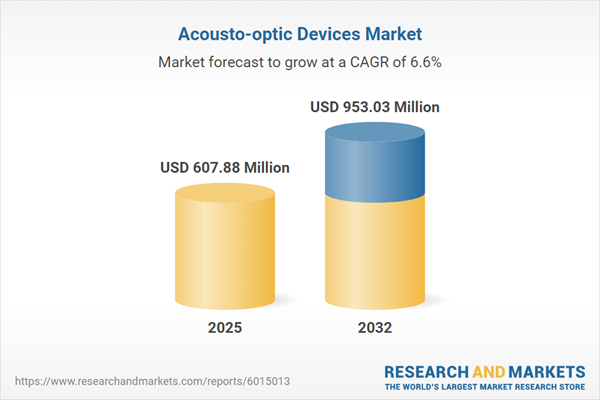Speak directly to the analyst to clarify any post sales queries you may have.
Across advanced industries, innovation in acousto-optic devices is reshaping the landscape of photonic applications, streamlining optical control, and accelerating progress in sectors from telecommunications to precision manufacturing.
Acousto-optic Devices Market Snapshot
The acousto-optic devices market grew from USD 572.23 million in 2024 to USD 607.88 million in 2025. It is expected to expand at a CAGR of 6.58%, reaching USD 953.03 million by 2032.
Senior executives seeking to optimize technology portfolios will find that acousto-optic components—recognized for their agility and precision—enable real-time optical modulation, supporting demanding environments where reliability and system integration are critical to performance and competitiveness.Comprehensive Scope & Segmentation
This report provides targeted analysis for leaders evaluating strategic investments, partnerships, or product portfolio expansion within the acousto-optic devices sector. Coverage includes:
- Product Types: Deflectors, Fiber Optics Devices, Frequency Shifters, Modulators, Q-Switches
- Material Composition: Calcium Molybdate, Crystal Quartz, Lead Molybdate, Tellurium Dioxide
- Reconfiguration Speeds: High, Medium, Low
- Applications: Laser Displays, Laser Processing, Medical Imaging, Optical Communications, Spectroscopy
- End User Industries: Aerospace & Defense, Healthcare, Industrial, Research, Telecommunication
- Regions Covered: Americas (United States, Canada, Mexico, Brazil, Argentina, Chile, Colombia, Peru), Europe, Middle East & Africa (e.g., United Kingdom, Germany, France, United Arab Emirates, South Africa), Asia-Pacific (including China, India, Japan, Australia, South Korea, Indonesia, Thailand, Malaysia, Singapore, Taiwan)
- Company Profiles: AA Opto Electronics Ltd., ALPHALAS GmbH, AMS Technologies AG, Brimrose Corporation of America, Coherent Corp., DayOptics, Inc., Gooch & Housego PLC, GWU-Lasertechnik Vertriebsgesellschaft mbH, Holmarc Opto-Mechatronics Ltd., IntraAction Corp., Isomet Corporation, L3Harris Technologies, Inc., Lambda Scientific Systems, Inc., Lightcomm Technology Co., Ltd., Panasonic Corporation, Photline Technologies, Quantifi Photonics Limited, RP Photonics AG, SAS Aerodiode, SeongKyeong Photonics Co., Ltd., SIMTRUM Pte. Ltd, Sintec Optronics Pte Ltd., Thorlabs, Inc., Yokogawa Electric Corporation
Key Takeaways for Senior Decision-Makers
- Acousto-optic devices are foundational for enabling precise, real-time control of laser outputs and optical beams, particularly in systems demanding rapid reconfiguration and minimal downtime.
- Advancements in crystalline materials and transducer engineering are supporting compact, high-power designs, making these components viable for space-constrained and mobile platforms, as well as rugged industry-specific use cases.
- The increasing integration of digital processing and artificial intelligence within device architectures is optimizing modulation efficiency while enabling remote monitoring and predictive maintenance functionalities.
- Broader adoption of acousto-optic solutions in telecommunications and imaging is being propelled by strategic industry collaborations and focused R&D investments, accelerating entry into medical diagnostics, aerospace, and next-generation manufacturing.
- Regional dynamics present distinct opportunities: North America and Europe are advancing integration into defense and industrial sectors; Asia-Pacific is rapidly scaling deployment in telecommunications and medical applications driven by manufacturing growth and policy incentives.
Impact of Newly Imposed Tariffs
For companies sourcing critical materials abroad, the introduction of United States trade tariffs in 2025 adds both complexity and cost pressure to the supply chain. Responses include diversification of supplier relationships, heightened investment in domestic crystal growth capacity, and renegotiated long-term sourcing contracts. End users have adopted buffer inventory strategies and value-added procurement services to mitigate volatility and sustain project timelines. These adjustments highlight the sector’s adaptability as it navigates new regulatory and cost environments.
Research Methodology & Data Sources
This market analysis synthesizes structured executive interviews, qualitative stakeholder workshops, and methodical review of academic, patent, and industry sources. Quantitative insights are generated through cross-segment comparison, scenario modeling, and validation by subject matter experts, producing reliable, actionable recommendations for strategy development in the acousto-optic devices industry.
Why This Report Matters
- Provides a comprehensive, segmented view of the acousto-optic devices market, informing investment, procurement, and product strategy.
- Highlights the disruptive potential of emerging materials, digital integration, and supply chain resiliency in shaping competitive advantage.
- Arms decision-makers with practical insights into managing tariff risk and guiding innovation in both established and emerging global regions.
Conclusion
Continuous advances in acousto-optic technologies are powering photonics innovation across critical industries, while new strategies in supply chain and technology integration position market leaders for sustained growth.
Additional Product Information:
- Purchase of this report includes 1 year online access with quarterly updates.
- This report can be updated on request. Please contact our Customer Experience team using the Ask a Question widget on our website.
Table of Contents
3. Executive Summary
4. Market Overview
7. Cumulative Impact of Artificial Intelligence 2025
Companies Mentioned
The companies profiled in this Acousto-optic Devices market report include:- AA Opto Electronics Ltd.
- ALPHALAS GmbH
- AMS Technologies AG
- A·P·E Angewandte Physik & Elektronik GmbH
- Brimrose Corporation of America
- Coherent Corp.
- DayOptics, Inc.
- Gooch & Housego PLC
- GWU-Lasertechnik Vertriebsgesellschaft mbH
- Holmarc Opto-Mechatronics Ltd.
- IntraAction Corp.
- Isomet Corporation
- L3Harris Technologies, Inc.
- Lambda Scientific Systems, Inc.
- Lightcomm Technology Co., Ltd.
- Panasonic Corporation
- Photline Technologies
- Quantifi Photonics Limited
- RP Photonics AG
- SAS Aerodiode
- SeongKyeong Photonics Co., Ltd.
- SIMTRUM Pte. Ltd
- Sintec Optronics Pte Ltd.
- Thorlabs, Inc.
- Yokogawa Electric Corporation
Table Information
| Report Attribute | Details |
|---|---|
| No. of Pages | 185 |
| Published | November 2025 |
| Forecast Period | 2025 - 2032 |
| Estimated Market Value ( USD | $ 607.88 Million |
| Forecasted Market Value ( USD | $ 953.03 Million |
| Compound Annual Growth Rate | 6.5% |
| Regions Covered | Global |
| No. of Companies Mentioned | 26 |









